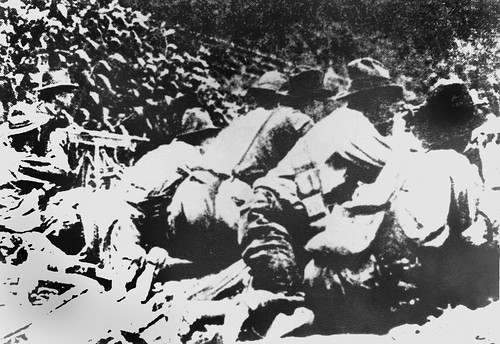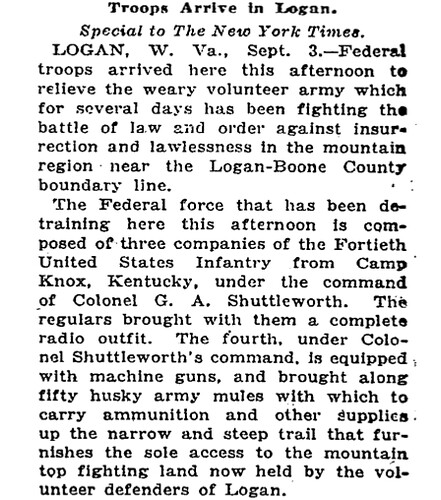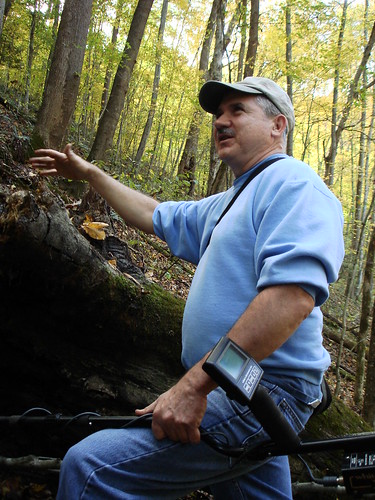News
Mountain Monday: The Legacy of Labor: Blair Mountain, WV
Monday, September 29th, 2008
In 2008, the United States stand to lose Blair Mountain,WV. Our loss may very well be at the hands of our own coal companies that want to see this special place turned into a mountaintop removal mining site. But before we can save it, we want people to understand why we believe the mountain deserves to stay.
…

 On August 25th, 1921 in Logan County, West Virginia, began a skirmish which would quickly swell into the largest armed labor conflict in American history. On the 1,600-acre Spruce Fork Ridge of Blair Mountain, there was a showdown between an army of as many as 15,000 pro-union miners and a federally backed 2,000-man defensive force. The miners – abused, exploited, and upset by lack of decent working conditions, living conditions, and lack of collective bargaining ability, had taken up arms. The United Mine Workers of America had been working to organize workers in the coalfields, due to constant oppression and tight control of coal-towns in Appalachia, and a long-simmering tension exploded into armed conflict upon to the murder of pro-union Matewan Police Chief Sid Hatfield.
On August 25th, 1921 in Logan County, West Virginia, began a skirmish which would quickly swell into the largest armed labor conflict in American history. On the 1,600-acre Spruce Fork Ridge of Blair Mountain, there was a showdown between an army of as many as 15,000 pro-union miners and a federally backed 2,000-man defensive force. The miners – abused, exploited, and upset by lack of decent working conditions, living conditions, and lack of collective bargaining ability, had taken up arms. The United Mine Workers of America had been working to organize workers in the coalfields, due to constant oppression and tight control of coal-towns in Appalachia, and a long-simmering tension exploded into armed conflict upon to the murder of pro-union Matewan Police Chief Sid Hatfield.
[Miners were] seeking the right not only to unionize but also to exercise civil liberties such as freedom of speech and assembly.
The anti-union defensive force was led by Logan County Sheriff Don Chafin and other law officers, many of whom were on the coal companies’ payrolls. Chafin’s men were “bolstered by private planes that dropped homemade bombs on the miners.” Blair Mountain remains the only place in our country where American’s have dropped bombs on other Americans from the air.
The New York Times archives reports: (9/3/1921) (html/.pdf)


Upon the arrival of federal troops, these coal-miners were quickly out-manned, outgunned, and surrounded. Enmeshed in the largest post-Civil War battle ever on American soil, the miners relented – refusing to fight their fellow veterans, whom many considered their fellow “brothers-in-arms” from WWI.
Across the invisible barriers of race and ethnicity, these coal-stained warriors had gathered enough support to be kept from unionizing only by the United States Army.
It turns out, however, that they may have ended up saving Blair Mountain. These days, the only way too keep Blair Mountain from being destroyed by the coal companies are by keeping it preserved as a historical site. In Fact, The National Trust for Historic Preservation recently recognized the Blair Mountain Battlefield, along with the neighborhoods of New Orleans, and the Vesey St staircase at the WTC, as one of the 11 most endangered historic places in the entire country.
Over the years, various local efforts to preserve the battle site have been blocked by the coal companies that own or lease the property where the conflict occurred. Now coal companies appear intent upon strip-mining Spruce Fork Ridge, which would completely obliterate the well-preserved and intact site. Only by drawing national attention to the importance of the events at Blair Mountain is this threatened battlefield likely to be saved.
Richard Moe, President of the National Trust for Historic Preservation, offers great perspective on the importance of this battle, and of the miners’ struggle because of its relation to current mining struggles.
“It is particularly important, given the recent mining tragedies in West Virginia, that we not lose this symbol of the bravery and determination of union miners to improve their working conditions.
Fierce opposition from the coal companies that own or lease most of the ridge – Hobet Mining, Arch Coal, Massey Energy Company and Aracoma Coal Company, among others – have stopped previous preservation attempts. The coal companies are intent on strip-mining, which would destroy the battlefield.

By increasing public awareness of the significance of the Blair Mountain battlefield, preservation advocates hope to win support for permanently protecting the site with easements and developing a economically sustainable interpretive program, possibly through the National Coal Heritage Area, which would allow the region to take advantage of West Virginia’s fastest-growing industry – tourism.
Protecting Blair Mountain is important because of the fact that, besides being one of the oldest and most beautiful mountains in the world, its historical significance is unparalleled. A historic site that would bring tourists to this breathtaking place is a far better long-term solution than simply blowing up the mountain for coal, as Massey Energy would have us do. We owe it not only to the mountain herself, but to those who gave their lives.
Up to 30 deaths were reported by Chafin’s side and 50-100 on the union miners side, with many hundreds more injured. By September 2, however, federal troops had arrived. Realizing he would lose a lot of good miners if the battle continued with the military, union leader Bill Blizzard passed the word for the miners to start heading home the following day. Miners fearing jail and confiscation of their guns found clever ways to hide rifles and hand guns in the woods before leaving Logan County. Collectors and researchers to this day are still finding weapons and ammunition embedded in old trees and in rock crevices. Thousands of spent and live cartridges have made it into private collections.
Which leads us to the discoveries of Kenny King and many many others. Harvard Ayers tells us that archeology may yet have a lot to tell us about the Battle of Blair Mountain that we do not yet know.
But the archeological record does more than simply corroborate the historical accounts. It adds considerable depth to our understanding of the battle. Whereas the history tells us that heavy fighting occurred at the three key locations, it does not tell us much about how these areas were defended. It documents in a broad sense the number of combatants, the main types of armaments (machine guns are frequently mentioned), and the broad ebb and flow of the battles. But it does not tell us for instance, the exact locations where the defenders made their stands. It does not detail how many of what weapons were used or the likely number of combatants at the defensive positions. The archeological record for the Battle of Blair Mountain has already yielded important information that fills some of these gaps in the historical record and has the potential to add even more to our understanding of the battle with future research.
… Of the thirteen archaeological sites documented by the reconnaissance surveys of West Virginia University and Appalachian State University, all are stated to have potential for yielding further important information about the Battle of Blair Mountain.
The story of Blair Mountain deserves to be told fully. To learn more about what you can do to help, please visit FriendsofBlairMountain.org
1. Featured Activist: Kenny King
 For over 17 years, one man has really been at the forefront of the charge to preserve Blair Mountain, and that is Kenny King. Mr. King has been the most passionate voice to fight for the preservation of this historic place, to tell people about the important battle that occurred there, and the attempt to ultimately list the 1,600-acre Spruce Fork Ridge on the National Park Service’s National Register of Historic Places. As a proud worker in the coal industry, he understands the significance of West Virginia’s coal heritage to the history of our country. Like many of us, he has a personal connection to the events at Blair Mountain – namely, relatives who fought on both sides of the battle. Please see the new America’s Most Endangered Mountain video about Blair Mountain to hear Kenny talk about his work to save Blair Mountain. A resident of Blair Mountain since 1962, Kenny explains how this historical site is threatened by a 333 acre mining permit. (h/t Greg Coble)
For over 17 years, one man has really been at the forefront of the charge to preserve Blair Mountain, and that is Kenny King. Mr. King has been the most passionate voice to fight for the preservation of this historic place, to tell people about the important battle that occurred there, and the attempt to ultimately list the 1,600-acre Spruce Fork Ridge on the National Park Service’s National Register of Historic Places. As a proud worker in the coal industry, he understands the significance of West Virginia’s coal heritage to the history of our country. Like many of us, he has a personal connection to the events at Blair Mountain – namely, relatives who fought on both sides of the battle. Please see the new America’s Most Endangered Mountain video about Blair Mountain to hear Kenny talk about his work to save Blair Mountain. A resident of Blair Mountain since 1962, Kenny explains how this historical site is threatened by a 333 acre mining permit. (h/t Greg Coble)
2. Virtual Flyover of Blair Mountain / Permit Area
As it is now, before the proposed mountaintop removal operations have started.
The boundaries of the historic area are outlined in yellow.

3. Appalachian Music of the Week
I just caught my first Martha Scanlan show last week and she was amazing. You may recognize her from the Reeltime Travelers, but I prefer her album West Was Burning. Live, her accompaniment (the Stuart twins) masterfully showcase a number of fiddle and old-time tunes, which makes their live show a real treat for anyone who likes contemporary or old-time acoustic music.
The West Was Burning:










